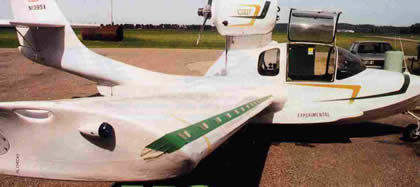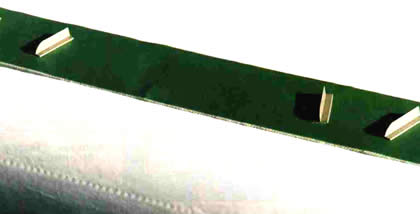

COOT VG: Vortex Generators make the amphibian fly very well
When EAAers get together they soon start talking about their airplanes, and it wasn't long ago that Roger Thistle (EAA 56766) told me how he lowered the stall speed of his Kitfox by putting votex generators (VGs) on it. At first I was skeptical about the results. How could gluing small pieces of extruded aluminum to the freshly painted wing of my Coot amphibian improve its performance? But if they would reduce the airplane's stall (and landing) speed, I was sure it was something the Coot's hull would appreciate.
After learning how VGs worked, I ordered them from Micro AeroDynamics Inc. because Roger Thistle was a satisfied customer. When the installation kit arrived a few days later, its completeness impressed me. In addition to the VGs, the kit included full-size paper templates with pre-cut guide holes for positioning each VG, isopropyyl alcohol for cleaning the surfaces, polystyrene cement to mount the VGs, and an X-Acto knife for cleaning away the excess glue. How well the VGs work depends on their location on the wing relative to each other and to the wing's leading edge. The Micro AeroDynamics kit included paper templates that established the optimum relationship between the pairs of VGs -- angled 30 º to the airflow and 9" between the pairs. Had we been flying one of the many standard-category airplanes for which the Company makes VG kits, we would have also received a template for placing the VGs in the optimal location with respect to the leading edge. however, since we were working with a homebuilt, we'd have to run our own tests.

A few weeks later, Al Checky, a fellow EAAer and my airframe and powerplant (A&P) mechanic, and I got together to test the VGs on my Coot. We got the airplane ready for the test flights the previous evening. To test the VGs in different locations, we used the paper templates to stick the vanes on two 14-foot lengths of double-sided carpet tape, so we could lift them off as a group and reposition them easily with respect to their distance aft of the leading edge. We also made some wing leading edge guides that would tell us precisely how far our templates were aft of the wing's leading edge.
The test day began as a beautiful cool (56ºF) Wisconsin summer morning, with a light (5 mph) breeze from the northwest. The Coot carried 150 pounds of fuel and 380 pounds of people, so our gross weight was around 2,180 pounds. Before applying the VGs Al and I flew to nearby Lake Wisconsin, and Al carefully measured the Coot's stall, landing and take-off speeds with a GPS and its take-off run with a stopwatch. (We divivded the flying and data measurement tasks to ensure maximum accuracy - and safety.) With our baseline measurements recorded, we repeated the tests with the VGs in three different locations: 2", 3" and 4" behind the leading edge of the wings. To keep the tests consistent, we added the amount of fuel consumed during each test before beginning the next one. We measured every test twice, and the averages are given in the Table below:
| VGs | Stall Speed | Landing Speed | Takeoff Speed | Takeoff Time |
|---|---|---|---|---|
| None | 49.5 mph | 65.6 mph | 61.0 mph | 33.5 sec. |
| 2" aft - LE | 49.5 mph | 69.1 mph | 66.2 mph | 36.5 sec. |
| 3" aft - LE | 48.4 mph | 59.3 mph | 55.8 mph | 32.0 sec. |
| 4" aft - LE | 49.5 mph | 64.5 mph | 55.8 mph | 34.5 sec. |
Our tests confirmed the predictions of Charles White, CEO of Micro AeroDynamics, that the VGs would perform best in the 3"-aft position. While the actual changes for this position may appear modest, the numbers don't tell the whole story. What impressed us most was that the Coot's warning buffet and tendency to fall off on one wing disappeared when the VGs were 3" aft, allowing us to achieve a full stall. We obtained the 48.4 mph number with the Coot mushing downward at 700 fpm -- perfectly stable with the wings level!
Overall, I'm very happy with our results because the Coot flies VG ("very good") with the VGs, just as the aeronautical engineers predicted. I have now attached the VGs permanently, and the only trouble they give me is an occasional scraped knuckle when I (carefully) wash the leading edges of the wings.